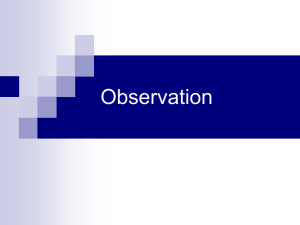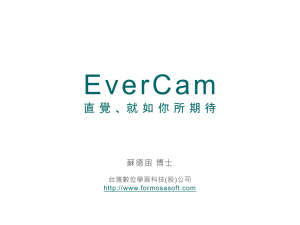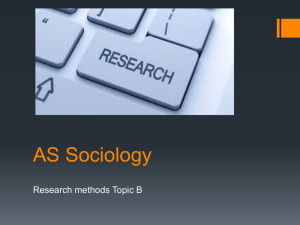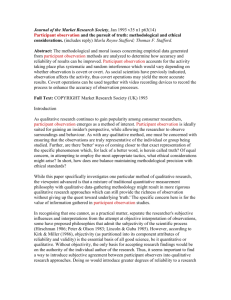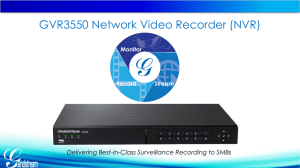Observation* - University of Mysore
advertisement
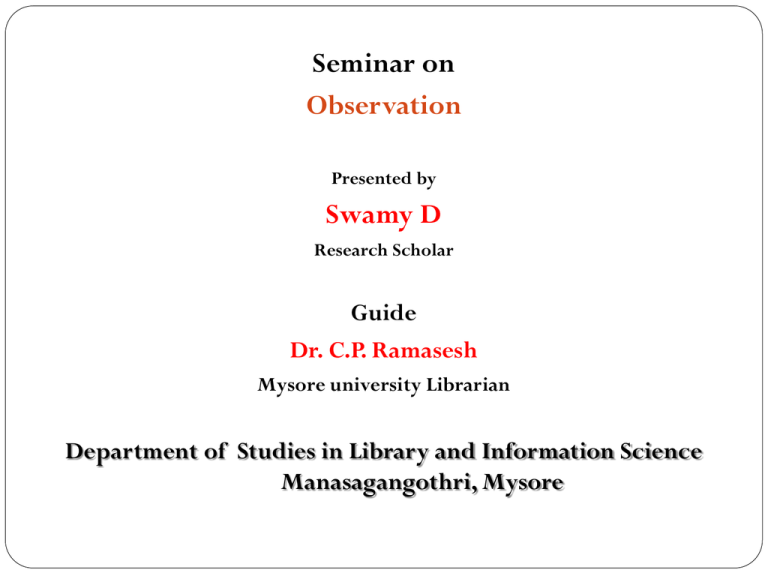
Seminar on Observation Presented by Swamy D Research Scholar Guide Dr. C.P. Ramasesh Mysore university Librarian Department of Studies in Library and Information Science Manasagangothri, Mysore Overview Introduction Meaning Definition Importance Why to observe ? Characteristics Types of observation Advantages and disadvantages Observation Tools And Recording Devices Introduction The observation method is the most commonly used method specially in studies relating to behavioural science. In a way we all observe thing around us, but this sort of observation is not scientific observation. Observation becomes a scientific tool and the method of data collection for the researcher, when it serves a formulated research purpose, is systematically planned and recorded and is subjected to checks and controls on validity and reliability. It is also a process of recording the behavior patterns of people, objects, and occurrences without questioning or communicating with them. Meaning Observation means viewing or seeing. We go on observing some thing or other while we are awake. Most of such observations are just casual and have no specific purpose. But observation as a method of data collection is different from such casual viewing. Definition Langley, P OBSERVATION involves looking and listening very carefully. We all watch other people sometimes, but we don't usually watch them in order to discover particular information about their behavior. This is what observation in social science involves Gorman and Clayton define observation studies as those that “involve the systematic recording of observable phenomena or behaviour in a natural setting” Why to observe ? Observation allows the researcher to study people in their 'natural setting' without their behaviour being influenced by the presence of a researcher. Observational data usually consists of detailed information about particular groups or situations. This kind of data can 'fill out' and provide a deeper, richer, understanding than survey work which tends to produce less detailed information about a larger number of people. Some methods only allow for the study of one individual at a time. Observation enables the research to study groups of people together, that is, it allows for the study of interaction between the members of a group. Characteristics of observation research Observation as a method of data collection has certain characteristics. 1. It is both a physical and a mental activity. The observation eye ‘catches’ many things which are sighted, but attention is focussed on data that are pertinent to the given study. 2. Observation is selective. A researcher does not observe anything and everything, but select the range of things to be observed on the basis of the nature, scope and objectives of his study. 3. Observation is purposive and not casual. It is made for the specific purpose of nothing things relevant to the study. 4. It captures the natural social context in which persons’ behaviour occurs. Types of observation Participant Observation Non-participant Observation Direct Observation Indirect Observation Controlled Observation Uncontrolled Observation Participant Observation : In this observation, the observer is a part of the phenomenon or group which observed and he acts as both an observer and a participant. Example, a study of tribal customs by an anthropologist by taking part in tribal activities like folk dance. The person who are observed should not be aware of the researcher’s purpose. Then only their behaviour will be ‘natural.’ Non - Participant Observation : in this method, the observer stands apart and does not participate in the phenomenon observed. Naturally, there is no emotional involvement on the part of the observer. This method calls for skill in recording observations in an unnoticed manner. Example : use of recording devices to examine the details of how people talk and behave together. Direct Observation : This means observation of an event personally by the observer when it takes place. This method is flexible and allows the observer to see and record subtle aspects of events and behaviour as they occur. He is also free to shift places, change the focus of the observation. Example: Observer is physically present to monitor Indirect Observation : This does not involve the physical presence of the observer, and the recording is done by mechanical, photographic or electronic devices. Example : Recording customer and employee movements by a special motion picture camera mounted in a department of large store. Controlled Observation : Controlled observation is carried out either in the laboratory or in the field. It is typified by clear and explicit decisions on what, how, and when to observe. It is primarily used for inferring causality, and testing casual hypothesis. Uncontrolled Observation : This does not involve over extrinsic and intrinsic variables. It is primarily used for descriptive research. Participant observation is a typical uncontrolled one. Planning observation The use of observation method require proper planning. The researcher should carefully examine the relevance of observation method to the data need of selected study. He must identify the specific investigative questions which call for use of observation method. These determine the data to be collected. He must decide the observation content, viz., specific conditions, events and activities that have to be observed for the required data. For each variable chosen, the operational definition should be specified. cont…. cont…. The observation setting, the subjects to be observed, the timing and mode of observation, recording procedure, recording instruments to be used, and other details of the task should be determined. Observation should be selected and trained. The persons to be selected must have sufficient concentration powers, strong memory power and unobtrusive nature. Selected persons should be imparted both theoretical and practical training Advantages of observation method They permit measurement of actual behavior rather than reports of intended or preferred behavior. There is no reporting bias, and potential bias caused by the interviewer and the interviewing process is eliminated or reduced. Certain types of data can be collected only by observation. If the observed phenomenon occurs frequently or is of short duration, observational methods may be cheaper and faster than survey methods. Disadvantages of observation method The reasons for the observed behavior may not be determined since little is known about the underlying motives, beliefs, attitudes, and preferences. Selective perception (bias in the researcher's perception) can bias the data. In some cases, the use of observational methods may be unethical, as in observing people without their knowledge or consent. Observation tools and recording devices Observation guides Recording sheets or checklist Schedule Field observation log Mechanical devices Observation guides : These are printed forms that provide space for recording observations. They are particularly useful when several observers are involved or when you wish to obtain comparable information from several sites/ observation points or observations of many people. The more structured the guide, the easier it will be to tally the results. Recording sheets or checklist : These forms are used to record observations as in YES/NO option (present – not present) or on a rating scale to indicate extent or quality of something. Checklists are used when there are specific, observable items, actions or attributes to be observed. Schedule : The data requirements are identified by analyzing the core of the problem, the objectives of the study, the investigative questions, hypothesis and the operational definition of concepts and out of the data requirements, items of data to be collected through observation are identified. A schedule is then constructed, covering those items of data. Field observation log : This may take the form of a diary or cards. Each item of observation is recorded under appropriate subheading. At the time of observation , rough noting may be made, and at the end of the day, fully log may be made. The card system is flexible and facilitates arrangement and re-arrangement of items in any desired order. Mechanical evices : These may include cameras, tape recorders, videotape and electronic devices. Still, motion , sound, colour and time lapse cameras give a permanent record of events. Microscopic and telescopic lens may be used in cameras. Eye cameras are common in advertising and package research. The camera makes a record that can be analyzed later and may be used to illustrate your evaluation report. Conclusion Under the observation method, the information is sought by way of investigator‘s own direct observation without asking from the respondent. For instance, in a study relating to consumer behavior, the investigator instead of asking the brand of wrist watch used by the respondent, may himself look at the watch. The main advantage of this method is that subjective bias is eliminated, as such is relatively less demanding of active cooperation on the part of respondents as happens to be the case in the interview or the questionnaire method. This method is particularly suitable in studies (i.e. respondents) who are not capable of giving verbal reports of their feelings for one reason or the other. Reference Kothari, C. R. (2008). Research methodology. (2 ed., p. 418). New Delhi: New Age Publications. Krishnaswamy , O. R. (2002). methodology of research in social science . (p. 529). Delhi: Himalaya Publishing house. Ronald , R. P., & Lynn , S. C. (2004). Basic research methods for librarians (library and information science text series). (4 ed., p. 200). New Delhi: Libraries Unlimited. Taylor, E. (n.d.). Collection evaluation data: direct observation . Retrieved from http://learningstore.uwex.edu/assets/pdfs/G3658-5.pdf THANK YOU

